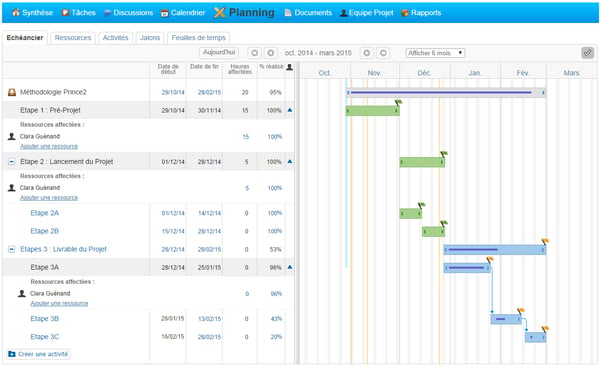Generally, Gantt charts are not very popular in business. The software used to generate them is often unnecessarily complex and confusing. Planning software does exist (MS Project is an example) but it is designed for large projects that require vast amounts of resources, furthermore it is specifically orientated to determine the feasibility of a project in time. Examples would include the construction of a new highway, the launch of an ERP client / server ...
But when planning software is used in a collaborative environment, it’s a lot easier to create and use a Gantt Chart, so you can view the progress of a project in real time and the involvment of all the people working on the project.
Read through some of our tips for creating your Gantt chart in a planning software.
Preliminary meetings = a structure that includes everyone
A project often involves employees from different departments, who don’t necessarily have the same titles or hierarchy. Employees from IT, sales, marketing often need to work together on a project but what is taken for granted, or understood in one department might be not be in another.
So it is important that right at the beginning the project manager or the person setting up the project includes everyone at a preliminary meeting where these issues might be addressed; each employee should explain his responsibilities and modus operandi. A brainstorming session allows everyone to familiarize themselves with the language used in other departments and come to an agreement of terms to be used in the Gantt chart. The employees involved are then often more willing to use it because they have contributed to its creation and understand it easily.
The preliminary meeting should include the following important points:
Identify project activites and deadlines

A project can easily be broken down into major activities: giving a logical guideline as to how it should be organized. Defining the start and end dates of each activity gives a good estimate of the overall duration of the project, although this may change as work progresses.
This is exactly why planning with software is so suitable, nothing is written in stone! If activity B must not begin before the end of the activity A and the latter is delayed, it will automatically shift the start/end dates of activity B.
Each activity may itself have a sub-activity, which in turn can be composed of several tasks. It is important to list all of the tasks required to complete a project. After all, it is the completion of one task after another which leads to a successful conclusion of a project.
Assign resources

The planning software also allows you to assign a resource to each activity or sub-activity on the project. In the jargon of project management, the term "resources" refers to a person or group of persons involved at some point in the project. The hours each resource needs to complete an activity should also be defined so that you can assess the workload associated with each activity. Once the `resources’ are assigned, they can follow the progress of the work of the activities or sub-activities for which they are responsible. The percentage of completion of each activity is easily identifiable on the schedule.
Add milestones

Milestones are not assigned resources or start/end dates and are visible to all. They mark an important step in an activity: the end of a stage; the confirmation of a client, the production of a document etc..
Visually represented on a schedule (usually as diamonds or flags), they clearly show the separate stages of a project and mark the achievement of milestones. They usually change color once complete.
The percentage of completion of activities, sub-activities and their associated tasks, combined with the achievement of milestones will determine whether the objective of a project is achieved.
That's it! We hope this short article has been helpful. Don’t hesitate to tell us how you create your Gantt chart with planning software!